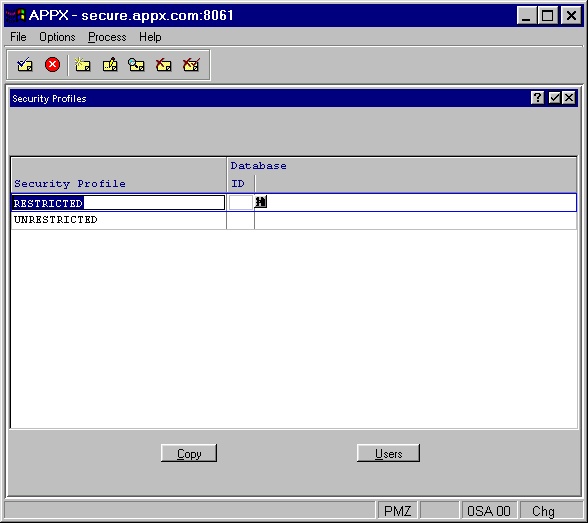
As described in the APPX Security section, APPX uses a system of security codes and security profiles to assist in protecting sensitive information stored on your system.. A security code is a four-digit number from 0000 to 9999, the rights to which are established in security profiles. A security profile contains the rights associated with a specific set of 10,000 security codes numbered from 0000 to 9999. These rights can be granted to one or more users at your installation by assigning the security profile to the user in the Users File Maintenance overlay. There can be any number of security profiles. In addition, a security profile name can be associated with specific database(s) and/or with a blank database which will serve to cover all other databases for that profile. Each security profile name/database combination can contain a different set of rights.
Security Profiles File Maintenance is used to establish and maintain security profiles. The first screen specifies the name of the security profile and its associated database, if any. Following screens are overlays in which you specify what rights or privileges are included in the security profile. Figure 2-51 is an example of the first screen in Security Profiles File Maintenance:

Figure 2-51. Security Profiles File Maintenance Screen
The Security Profiles File Maintenance screen contains the following fields:
∑ Security Profile identifies the name of the security profile. Any profile can be set up with a blank database ID, and also in association with one or more valid databases. The profile associated with a blank database may be used for any database. If the same profile exists with a valid database, that profile overrides any values set up in the profile/blank database record, for that database only. If a user has been given a security profile, and attempts to access a database, APPX will look first for a profile/database combination that matches the userís profile and the selected database. If found, the user will be allowed access to any data and process objects which match the selected profile. If no such profile/database record exists, APPX will then look for a profile/blank database record matching the userís profile. If found, the user will be allowed access to any data and process objects which match that profile. If no such profile/database record exists, APPX will deny the user access to any data or process object containing a security code.
∑ Database ID identifies a valid database that you want this security profile to be associated with. This profile will take precedence over the same profile with a blank database ID, for this database.
The Security Profiles File Maintenance screen contains two options:
∑ Copy allows you to copy the security rights of another security profile to the current security profile. See the Security Profiles Copy Rights Table overlay for details.
∑ Users displays a list of users currently assigned to this profile.
When you select a profile and press Enter, the Security Profiles File Maintenance overlay appears. This overlay is described in the next section.